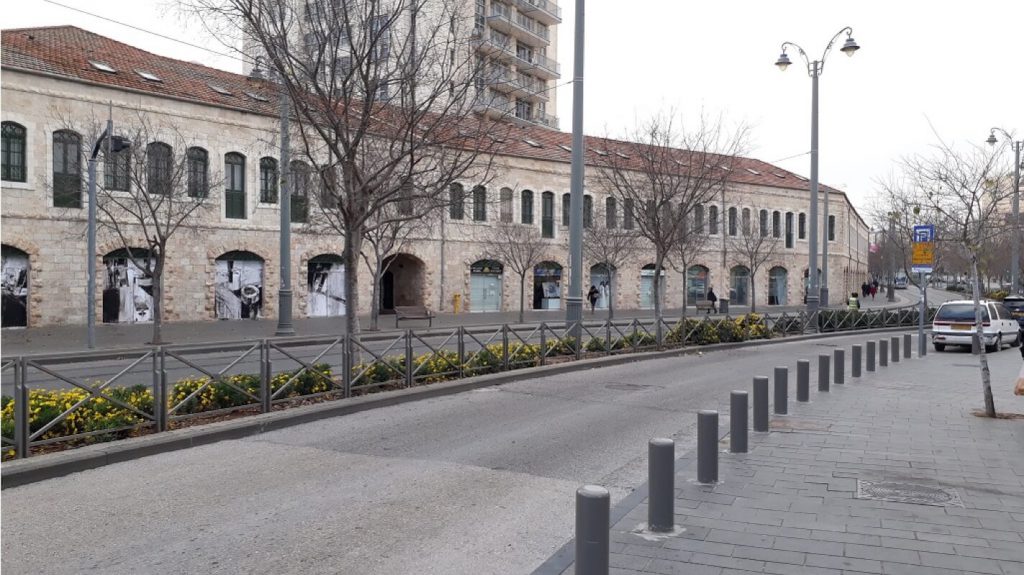Beita Today
Beita – House of Art and City is an urban art center operated by the Visual Art Department of the Culture and Arts Administration, Jerusalem Municipality. The center was established in 2014 in the historic Batei Saidoff (“Saidoff Houses”) on Jaffa Road, near Machne Yehuda Market. Actively fostering and hosting art exhibitions and initiatives while serving as a center for art tourism in Jerusalem, Beita sees it as its mission to examine and encourage the affinities between art, society, and the city of Jerusalem, on all of its shades and complexities. Beita includes an active contemporary art gallery, design and art classes, permanent residence of Muslala wood workshop, art tours, and the Outline Festival for Illustration and Words in
The Story of Batei Saidoff
Beita is located on Jaffa Road in the heart of Jerusalem, along the Light Rail route. The center operates in the historic Batei Saidoff (“Saidoff Houses”), a former courtyard neighborhood that once housed many of Jerusalem’s craftsmen and artisans. Assigned to the Visual Arts Department of Jerusalem Municipality in 2012, in 2014 it was inaugurated as a meeting place for artists, educators, creatives, and residents, striving to facilitate common creation and dialogue. The location of Beita in Batei Saidoff sets to recount the story of the historic complex, which combines several classical construction styles of a courtyard neighborhood, most notably a Bukharan Jewish style, which was prevalent in Jerusalem in the early 20th century, and combines residential houses, stores, and small workshops.
Saidoff neighborhood was built in 1911 between Beit Yaakov neighborhood and the old Sha’arei Zedek Hospital by Yitzhak Saidoff, a wealthy Bukharan Jew. The central building in the neighborhood was a large and elongated, somewhat bowl-shaped two-story structure. The lower story faced Jaffa Road and housed a row of shops and workshops that boasted wide and decorative gates. The back of the shops, which served as the homes of the shop owners and their families, faced the inner courtyard where a large willow tree shaded two water cisterns and the common toilet. By the neighborhood gate, a large stone staircase led to the second floor, which housed spacious apartments, balconies, and a synagogue. Over the years, the building started to deteriorate and its residents had to move out. Temporary structures were erected in the courtyard and artists and craftsmen returned to work in it. Alongside established workshops like the legendary Zohar mosaic factory (est. 1939) and the Gottlieb-Bomtz tiles and blocks factory, new woodshops, ateliers, and artist studios opened in the complex, creating a dynamic unofficial art scene.
This building is unique in its central location in the heart of Jerusalem, in its architecture, and in the fact that it recounts the story of the city and its significant social, economic, and urban transformations. The history of the building goes back to the early 20th century with vibrant community life, shops, and workshops, alongside cramped living conditions, the bustle of children, common toilets, two cisterns and a synagogue. In the 1980s, when the building was dilapidated and on the verge of deterioration, it was used by Jerusalemite artists and craftsmen for dwelling, improvised work spaces and cultural events. Then, in the early 2000s, Batei Saidoff underwent extensive conservation and renovation as part of a luxury residential and commerce project initiated by the Ashder real estate company. A 23-story sky scraper was built in its inner courtyard.
The Foundation of Beita
Beita was established as part of a collaboration of artists who work in the urban space and the city’s residents in the desire to bring together the elements that shape the city. The curational view that guided the place wished to explore the site’s past as the foundation for its future. Beita’s inaugural exhibition was based on a three and a half long research and practice residency of a multidisciplinary group of ten artists. The artists wished to recount the story of Batei Saidoff as a way to discover the city and the urban, ethical, and social changes it experienced, and as an opportunity to rethink its future. In the exhibition, Elad Yaron presented an original documentation file of the complex, with information about the construction of Batei Saidoff alongside residents’ stories about the history of the place Dafna Shalom created a mobile studio and a series of photographic portraits Yair Asaf Shapira and Noam Kuzar planned a dynamic map of the city based on an open mapping system, sharing communal data based on personal interest. Eitam Tubul created a new authority – the Amulets Authority, where amulets answer secret prayers and contemporary wishes of the city’s residents, Matan Pinkas presented a short film about the main tensions in Israeli society, Nati Shamia Offer created a plan for a factory that makes tiles out of bird’s food; and Chaya Rukin and Meirav Savirski offered performative art walks in the urban space. Since then, Beita has continued to serve as a place for artmaking that is inherently connected to the city and to the society that makes it.

